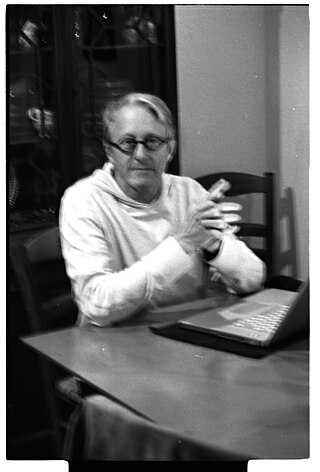Related Research Articles

Abbot Howard Hoffman was an American political and social activist who co-founded the Youth International Party ("Yippies") and was a member of the Chicago Seven. He was also a leading proponent of the Flower Power movement.

The Youth International Party (YIP), whose members were commonly called Yippies, was an American youth-oriented radical and countercultural revolutionary offshoot of the free speech and anti-war movements of the late 1960s. It was founded on December 31, 1967. They employed theatrical gestures to mock the social status quo, such as advancing a pig as a candidate for President of the United States in 1968. They have been described as a highly theatrical, anti-authoritarian, and anarchist youth movement of "symbolic politics".

Shirley Clarke was an American filmmaker.

A Portapak is a battery-powered, self-contained video tape analog recording system. Introduced to the market in 1967, it could be carried and operated by one person.
A pirate television station is a broadcast television station that operates without a broadcast license. Like its counterpart pirate radio, the term pirate TV lacks a specific universal interpretation. It implies a form of broadcasting that is unwelcome by the licensing authorities within the territory where its signals are received, especially when the country of transmission is the same as the country of reception. When the area of transmission is not a country, or when it is a country and the transmissions are not illegal, those same broadcast signals may be deemed illegal in the country of reception. Pirate television stations may also be known as "bootleg TV", or confused with licensed low-power broadcasting (LPTV) or amateur television (ATV) services.

Michael Shamberg is an American film producer and former Time–Life correspondent.

Lord of the Universe is a 1974 American documentary film about Prem Rawat at an event in November 1973 at the Houston Astrodome called "Millennium '73". Lord of the Universe was first broadcast on PBS on February 2, 1974, and released in VHS format on November 1, 1991. The documentary chronicles Maharaj Ji, his followers and anti-Vietnam War activist Rennie Davis who was a spokesperson of the Divine Light Mission at the time. A counterpoint is presented by Davis' Chicago Seven co-defendant Abbie Hoffman, who appears as a commentator. It includes interviews with several individuals, including followers, ex-followers, a mahatma, a born-again Christian, and a follower of Hare Krishna.
TVTV was a San Francisco-based video collective that produced documentary video works using guerrilla art techniques.
The Police Tapes is a 1977 documentary about a New York City police precinct in the South Bronx. The original ran ninety minutes and was produced for public television; a one-hour version later aired on ABC.
Abbie Marie Boudreau is an American ABC television news correspondent. She joined ABC in November 2010. She was formerly with CNN. She has received seven regional Emmys for investigative reporting, writing and enterprise journalism. She also received regional Edward R. Murrow awards in both 2006 and 2007. Since joining ABC Abbie has received three national Emmy Awards, a national Edward R. Murrow award and a Gracie award for her ensemble work on Good Morning America.

Video Data Bank (VDB) is an international video art distribution organization and resource in the United States for videos by and about contemporary artists. Located in Chicago, Illinois, VDB was founded at the School of the Art Institute of Chicago in 1976 at the inception of the media arts movement.

Chip Lord is an American media artist and Professor Emeritus, UC Santa Cruz and residing in San Francisco. He is best known for his work with the alternative architecture and media collective known as Ant Farm, which he co-founded with Doug Michels in 1968. His work generally takes a satirical look at American myths and legends, they are often "nostalgic, but edged with an ironic detachment."
Skip Blumberg is an American filmmaker. He is one of the original camcorder-for-broadcast TV producers, and among the first wave of video artists in the 1970s. His early work reflects the era's emphasis on guerrilla tactics and medium-specific graphics, but his more recent work takes on more global issues. His work has screened widely on television and at museums. His video Pick Up Your Feet: The Double Dutch Show (1981) is considered a classic documentary video and was included in the Museum of Television and Radio's exhibition TV Critics' All-time Favorite Shows. His cultural documentaries and performance videos have been broadcast on PBS, National Geographic TV, Showtime, Bravo, Nickelodeon, among others.
TV Lab was a program founded at Thirteen/WNET public television station in 1972 by David Loxton with support from the Rockefeller Foundation and New York State Council on the Arts. The program provided artists with advanced video making equipment through an artist-in-residence program. Between 1975 and 1977, the Video Tape Review series was established and broadcast through TV Lab. David Loxton created TV Lab's Independent Documentary Fund in 1977, aiming to provide funding for the creation of independent documentaries. Unable to match funds from the National Endowment for the Arts, the IDF and TV Lab lost support, eventually ending in 1984.
A multi-channel network (MCN) is an organization that works with video platforms to offer assistance to channel owners in areas such as "product, programming, funding, cross-promotion, partner management, digital rights management, monetization and sales, and audience development," in exchange for a percentage of the ad revenue from the channel.
Parry Teasdale is an American video artist and a founding member of the early video collective Videofreex. He was also involved with Lanesville TV, one of the first unlicensed TV stations, throughout the 1970s.
Four More Years is a 1972 documentary covering the 1972 Republican National Convention produced by Top Value Television. The title of the film refers to Richard Nixon's re-election slogan. The convention named Nixon as the Presidential nominee and Spiro Agnew as the nominee for Vice President. All filming takes place on the site of the convention center in Miami Beach, Florida. It was TVTV's second production, after The World's Largest TV Studio (1972), which covered the Democratic Convention one month prior.
Anda Korsts was a Chicago-based video artist and journalist. She was the founder of Videopolis, Chicago's first alternative video space, and worked with TVTV, a national video collective. She was one of the first of many new artists to use the portable camcorder as a tool for art making and radical journalism.

Judy Hoffman is an American filmmaker and arts activist based in Chicago. She graduated from Northwestern University with a MFA and currently holds a faculty position at the University of Chicago. Hoffman has played a major role in the development of Kartemquin Films, a documentary filmmaking company founded in Chicago in 1966. Hoffman has worked with extensively with Kwakwaka’wakw, a First Nation in British Columbia, to produce films. Hoffman has brought activism to her films, and continues to show different facets of the city of Chicago.

Mary Curtis Ratcliff is an American visual artist.
References
- ↑ MICHEL, KAREN (22 March 2015). "Decades Before YouTube, Video Pioneers Captured Turbulent Era". NPR. Archived from the original on 27 March 2015. Retrieved 29 March 2015.
- ↑ "About the Group". Videofreex.com Digital Archive 1969-2019. Archived from the original on 29 December 2022. Retrieved 29 December 2022.
- ↑ Teasdale, Parry. America's First Pirate TV Station & the Catskills Collective That Turned it On. Black Dome Press Corps.
- 1 2 "Videofreex". Archived from the original on August 18, 2010. Retrieved May 6, 2010.
- ↑ HODARA, SUSAN (28 February 2015). "Before YouTube, Experimenting With Video". The New York Times . Archived from the original on 2 April 2015. Retrieved 29 March 2015.
- ↑ "Videofreex Archives". Video Data Bank. Archived from the original on 4 March 2016. Retrieved 29 March 2015.
- ↑ Kenny, Glenn (2016-03-08). "Review: "Here Come the Videofreex," Revolution via the Portapak". Archived from the original on 2022-12-29. Retrieved 29 December 2022.